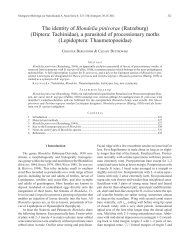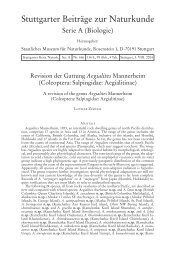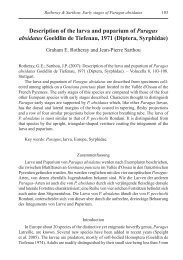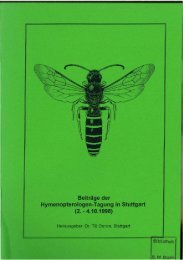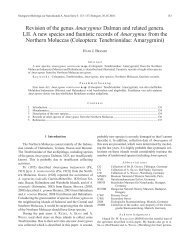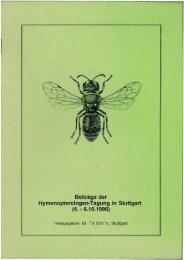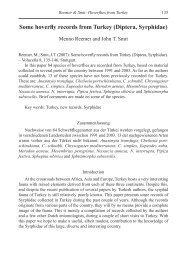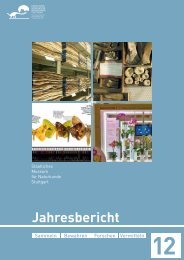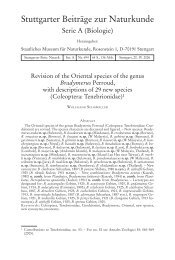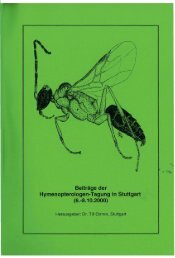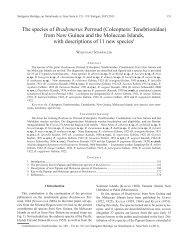450 STUTTGARTER BEITRÄGE ZUR NATURKUNDE A Neue Serie 4groups, <strong>the</strong> freshwater fish fauna is dom<strong>in</strong>ated by <strong>the</strong> familiesGobiidae, Eleotridae, Anguillidae <strong>and</strong> Mugilidae; <strong>the</strong>most speciate mar<strong>in</strong>e fish groups are <strong>the</strong> Gobiidae, Labridae,<strong>and</strong> Pomacentridae. A total <strong>of</strong> 61 fish species are recordedfrom <strong>New</strong> <strong>Caledonia</strong> for <strong>the</strong> first time.The fish fauna <strong>of</strong> <strong>New</strong> <strong>Caledonia</strong> <strong>in</strong>cludes a total <strong>of</strong> 125species occurr<strong>in</strong>g <strong>in</strong> freshwater (plus 8 <strong>in</strong>troduced species,6.4 % <strong>of</strong> <strong>the</strong> total freshwater fish species), 266 species<strong>of</strong> transitional waters (plus two <strong>in</strong>troduced species,0.8 % <strong>of</strong> <strong>the</strong> total transitional water species) <strong>and</strong> 2320 species<strong>in</strong> mar<strong>in</strong>e habitats. Freshwater <strong>and</strong> transitional waterspecies are found almost exclusively <strong>in</strong> <strong>the</strong> Gr<strong>and</strong>e TerreGroup, as <strong>the</strong>re are no open fresh water habitats <strong>in</strong> <strong>the</strong> outerisl<strong>and</strong>s.Among <strong>the</strong> mar<strong>in</strong>e species, 905 species are recordedfrom isl<strong>and</strong>s <strong>and</strong> reefs <strong>of</strong> <strong>the</strong> East Coral Sea (<strong>in</strong>clud<strong>in</strong>gChesterfield Isl<strong>and</strong>s) (39.1 % <strong>of</strong> <strong>the</strong> total mar<strong>in</strong>e species),193 pelagic <strong>and</strong> deepsea species are known from <strong>the</strong><strong>New</strong> <strong>Caledonia</strong>n bas<strong>in</strong> (8.3 % <strong>of</strong> <strong>the</strong> total mar<strong>in</strong>e species),1860 species from <strong>the</strong> Gr<strong>and</strong>e Terre Group (80.3 % <strong>of</strong> <strong>the</strong>total mar<strong>in</strong>e species), 85 species from <strong>the</strong> Norfolk Ridge(3.7 % <strong>of</strong> <strong>the</strong> total mar<strong>in</strong>e species), <strong>and</strong> 1029 species from<strong>the</strong> Loyalty Ridge <strong>in</strong>clud<strong>in</strong>g Loyalty Isl<strong>and</strong>s (42.3 % <strong>of</strong> <strong>the</strong>total mar<strong>in</strong>e species). The Gr<strong>and</strong>e Terre Group <strong>in</strong>cludesmany species liv<strong>in</strong>g o<strong>the</strong>rwise along cont<strong>in</strong>ental shelves,which prefer nutrient rich waters. In <strong>the</strong> Loyalty Isl<strong>and</strong>s,several species restricted to oceanic isl<strong>and</strong>s <strong>in</strong>clud<strong>in</strong>g socalled‘Pacific Plate species’ are found; such species requiremar<strong>in</strong>e habitats with few nutrients. Many <strong>of</strong> <strong>the</strong> latterspecies, especially <strong>in</strong> deeper water, are small.It is difficult to compare <strong>the</strong> faunas <strong>of</strong> nearby regionsas <strong>the</strong> sampl<strong>in</strong>g effort is very heterogeneous from one regionto <strong>the</strong> next. Restrict<strong>in</strong>g <strong>the</strong> comparison to <strong>the</strong> coastalspecies (mar<strong>in</strong>e species, found <strong>in</strong> less than 80 m exclud<strong>in</strong>goceanic pelagic species) <strong>the</strong>re is a very high similarity<strong>in</strong> <strong>the</strong> rank<strong>in</strong>g <strong>of</strong> <strong>the</strong> various families (Tab. 1). The onlyexception be<strong>in</strong>g <strong>the</strong> Nor<strong>the</strong>rn <strong>New</strong> Zeal<strong>and</strong> Region whichis at <strong>the</strong> limit <strong>of</strong> <strong>the</strong> tropical waters <strong>and</strong> <strong>the</strong>refore has lessspecies <strong>and</strong> is <strong>in</strong>fluenced by <strong>the</strong> occurrence <strong>of</strong> colder waters.There are also several important families which arenot represented or weakly represented <strong>in</strong> <strong>New</strong> <strong>Caledonia</strong>compared to <strong>the</strong> western <strong>and</strong> nor<strong>the</strong>rn regions (GreatBarrier Reef, Papua <strong>New</strong> Gu<strong>in</strong>ea <strong>and</strong> Solomon Isl<strong>and</strong>s).In particular <strong>the</strong>re are no Ariidae or Sciaenidae <strong>in</strong> <strong>New</strong><strong>Caledonia</strong> <strong>and</strong> families such as Platycephalidae, Soleidae,Sillag<strong>in</strong>idae, Syngnathidae, Siganidae, Pseudochromidae,Chaetodontidae <strong>and</strong> Hemiramphidae have less species than<strong>in</strong> <strong>the</strong> west <strong>and</strong> north. On <strong>the</strong> contrary, several families areTab. 1. Proportion (percent <strong>of</strong> total) <strong>and</strong> rank (<strong>in</strong> paren<strong>the</strong>ses) <strong>of</strong> <strong>the</strong> 20 most speciose families <strong>of</strong> shore <strong>fishes</strong> <strong>in</strong> <strong>the</strong> southwesternPacific. Only “shore” species are <strong>in</strong>cluded, i. e. species which are mar<strong>in</strong>e, live <strong>in</strong> less than 80 m depth <strong>and</strong> are not found as adults <strong>in</strong><strong>the</strong> oceanic pelagic waters.<strong>New</strong><strong>Caledonia</strong>VanuatuGreatBarrier ReefPapua <strong>New</strong>Gu<strong>in</strong>eaSolomonIsl<strong>and</strong>sNor<strong>the</strong>rn<strong>New</strong>Zeal<strong>and</strong>Gobiidae 11.9 (1) 9.5 (1) 10.4 (1) 10.4 (1) 11.7 (1) 6.3 (2) 11.6 (1) 11.2 (1)Labridae 7.2 (2) 8.5 (2) 6.5 (2) 6 (2) 6.4 (3) 12.5 (1) 6.9 (2) 7.9 (2)Pomacentridae 5.8 (3) 8.1 (3) 5.3 (3) 5.5 (3) 7.2 (2) 6.3 (2) 5.6 (3) 7.1 (3)Apogonidae 4.9 (4) 4.4 (6) 3.9 (5) 5.3 (4) 5.9 (4) 2.6 (10) 5 (4) 5.2 (5)Serranidae 4.7 (5) 5.2 (4) 4.3 (4) 4.1 (5) 4.4 (6) 4.9 (4) 4.7 (5) 4.6 (6)Blenniidae 4 (7) 4.5 (5) 3.1 (6) 3.6 (6) 4.7 (5) 4.3 (5) 4.5 (6) 5.4 (4)Muraenidae 4.4 (6) 3.4 (7) 2.2 (10) 2.3 (10) 2.3 (10) 2.9 (9) 3.4 (7) 3.9 (7)Carangidae 2.1 (10) 2.8 (9) 3 (7) 2.4 (8) 3 (7) 2.5 (11) 2.9 (8) 2.9 (10)Syngnathidae 2.4 (9) 1.9 (15) 2.9 (8) 2.7 (7) 2.5 (8) 1.2 (19) 2.8 (9) 1.9 (15)Chaetodontidae 1.7 (12) 2.6 (10) 2.1 (11) 2.1 (11) 2.4 (9) 4 (6) 2.3 (11) 3.1 (8)Scorpaenidae 3.1 (8) 2 (14) 2.2 (9) 2.3 (9) 1.9 (13) 2.3 (12) 2.5 (10) 1.5 (16)Acanthuridae 2.1 (11) 2.9 (8) 1.8 (12) 1.6 (13) 2.2 (11) 3.5 (7) 2.2 (12) 3.1 (8)Lutjanidae 1.5 (17) 2.6 (10) 1.4 (16) 1.7 (12) 2.1 (12) 1.4 (18) 2.2 (12) 2.1 (13)Scaridae 1.5 (14) 2.2 (13) 1.4 (16) 1.3 (18) 1.5 (15) 3.2 (8) 1.7 (16) 2.6 (11)Holocentridae 1.5 (14) 1.9 (15) 1.2 (19) 1.3 (18) 1.7 (14) 1.1 (21) 1.9 (15) 2.5 (12)Tripterygiidae 1.6 (13) 2.6 (12) 1.5 (15) 1.5 (14) 1.3 (17) 0.8 (25) 1.3 (21) 2.1 (13)Tetraodontidae 1.5 (14) 1.3 (20) 1.5 (14) 1.4 (15) 1.1 (20) 1.8 (14) 1.4 (18) 1.4 (17)Ophichthidae 1.3 (18) 1 (22) 1.2 (19) 1 (25) 1 (23) 1.6 (15) 2.1 (14) 1.4 (20)Pomacanthidae 1.1 (22) 1.7 (17) 1.2 (23) 1.1 (23) 1.4 (16) 1.6 (15) 1.4 (18) 1 (23)Lethr<strong>in</strong>idae 1.2 (20) 1.5 (18) 1.1 (24) 1.1 (22) 1.1 (21) 0.9 (22) 1.6 (17) 1.4 (20)Total number<strong>of</strong> species1851 1306 2161 2298 1757 710 1462 1067FijiTonga
FRICKE ET ALII, CHECKLIST OF FISHES OF NEW CALEDONIA 451well represented, Balistidae, Muraenidae <strong>and</strong> Scorpaenidaehave more species than <strong>in</strong> any o<strong>the</strong>r country <strong>in</strong> <strong>the</strong>southwestern Pacific.<strong>New</strong> <strong>Caledonia</strong> has a considerable endemic element <strong>of</strong>107 species known to date (4.6 % <strong>of</strong> <strong>the</strong> total native species).Among <strong>the</strong> known endemic species, 47 occur at <strong>the</strong>Gr<strong>and</strong>e Terre Group (43.9 % <strong>of</strong> <strong>the</strong> total endemic species),18 <strong>in</strong> <strong>the</strong> eastern Coral Sea (16.8 %), 6 on <strong>the</strong> LoyaltyRidge (5.6 %), <strong>and</strong> 11 on <strong>the</strong> Norfolk Ridge (10.3 %). Therema<strong>in</strong><strong>in</strong>g endemic species occur <strong>in</strong> more than one subregion.The high number <strong>of</strong> Gr<strong>and</strong>e Terre Group endemicsis correlated with an old geological age <strong>and</strong> a long isolation<strong>of</strong> that group (separated s<strong>in</strong>ce 68 million years, see FRICKE1997: 49). Due to <strong>the</strong> high percentage <strong>of</strong> endemic species,<strong>New</strong> <strong>Caledonia</strong> is considered as an endemism centre.Endemic species are distributed amongst 41 families.However only six families have five or more endemic species(Tab. 2). The proportion <strong>of</strong> endemic species also displaysan unusual pattern. The highest proportions are foundamong bottom dwell<strong>in</strong>g species, especially flat<strong>fishes</strong> <strong>and</strong>Callionymidae. Most endemic species are small (some lessthan 15 cm st<strong>and</strong>ard length, most even less than 10 cm),with some exceptions among <strong>the</strong> Chondrichtyans. Manyimportant families such as <strong>the</strong> Pomacentridae, Muraenidae,Scorpaenidae, Acanthuridae, Blenniidae, Carangidae,Lutjanidae have no endemic species <strong>in</strong> <strong>New</strong> <strong>Caledonia</strong>.However, it should be noticed that <strong>the</strong> proportion <strong>of</strong>endemic species is significantly higher among deep waterspecies <strong>and</strong> species recently described. This effect is probablyl<strong>in</strong>ked to sampl<strong>in</strong>g effort, as deep water species haveTab. 2. Number <strong>of</strong> <strong>New</strong> <strong>Caledonia</strong>n endemic fish species perfamily. Only families with at least two endemic species are <strong>in</strong>cluded.FamilyEndemicspecies <strong>in</strong>familyTotal species<strong>in</strong> familyPercentage <strong>of</strong>endemicspecies <strong>in</strong>familyBothidae 10 35 28.6Gobiidae 9 190 4.7Macrouridae 9 52 17.3Callionymidae 8 24 33.3Samaridae 5 9 55.6Syngnathidae 5 43 11.6Serranidae 4 95 4.2Triglidae 4 12 33.3Apogonidae 3 81 3.7Congridae 3 23 13.0Ophichthidae 3 24 12.5Scyliorh<strong>in</strong>idae 3 4 75.0Sparidae 3 4 75.0Urolophidae 3 3 100.0Bythitidae 2 8 25.0not been well sampled <strong>in</strong> most regions around <strong>New</strong> <strong>Caledonia</strong><strong>and</strong> recently described species are likely to be found<strong>in</strong> o<strong>the</strong>r regions once more material becomes available.Compared to o<strong>the</strong>r areas <strong>in</strong> <strong>the</strong> southwestern Pacific, <strong>New</strong><strong>Caledonia</strong> has a higher proportion <strong>of</strong> endemic species thanregions to <strong>the</strong> north <strong>and</strong> east (Papua <strong>New</strong> Gu<strong>in</strong>ea, SolomonIsl<strong>and</strong>s, Vanuatu, Fiji or Tonga), similar to <strong>the</strong> GreatBarrier Reef, but lower than <strong>the</strong> Nor<strong>the</strong>rn <strong>New</strong> Zeal<strong>and</strong>Region (Lord Howe Isl<strong>and</strong>, Norfolk, Isl<strong>and</strong> Elizabeth <strong>and</strong>Middleton Reef, Kermadec Isl<strong>and</strong>s).Several species are not endemic to <strong>New</strong> <strong>Caledonia</strong> buthave not been recorded from o<strong>the</strong>r parts <strong>of</strong> <strong>the</strong> southwesternPacific. There is not enough <strong>in</strong>formation on <strong>the</strong> geographical<strong>distribution</strong> <strong>of</strong> deepwater <strong>and</strong> pelagic species,but 60 shore fish species (mar<strong>in</strong>e species liv<strong>in</strong>g <strong>in</strong> less than80 m <strong>and</strong> not liv<strong>in</strong>g as adults <strong>in</strong> oceanic pelagic waters)have this pattern. The majority (45 species) <strong>of</strong> <strong>the</strong>se speciesare small (less than 10 cm). Some <strong>of</strong> <strong>the</strong>m are o<strong>the</strong>rwiseknown only from <strong>the</strong> tropical nor<strong>the</strong>rn hemisphere(Japan, Taiwan, Hawaii), <strong>and</strong> such species were def<strong>in</strong>ed asantitropical/antiequatorial by RANDALL (1982). It is possiblethat some <strong>of</strong> <strong>the</strong>se species are ei<strong>the</strong>r misidentificationsor represent cryptic species.Zoogeographically, <strong>the</strong> shallow ichthy<strong>of</strong>auna <strong>of</strong> <strong>the</strong>Chesterfield Isl<strong>and</strong>s has close aff<strong>in</strong>ities with <strong>the</strong> GreatBarrier Reef <strong>and</strong> reefs <strong>in</strong> <strong>the</strong> West Coral Sea; however,a few species have a bipolar, antiequatorial <strong>distribution</strong>,with a <strong>distribution</strong> range at <strong>the</strong> Chesterfield Isl<strong>and</strong>s <strong>and</strong><strong>in</strong> <strong>the</strong> Western North Pacific Ocean. In <strong>the</strong> Gr<strong>and</strong>e TerreGroup, we f<strong>in</strong>d aff<strong>in</strong>ities with eastern Australia, <strong>New</strong>Gu<strong>in</strong>ea, <strong>and</strong> Vanuatu. In sou<strong>the</strong>rn Gr<strong>and</strong>e Terre <strong>and</strong> <strong>the</strong>Île des P<strong>in</strong>s, several southwestern Pacific isl<strong>and</strong> endemicsare found, which are o<strong>the</strong>rwise distributed at Lord Howe<strong>and</strong> Norfolk isl<strong>and</strong>s. The (deepwater) Norfolk Ridge ichthy<strong>of</strong>aunahas close aff<strong>in</strong>ities with nor<strong>the</strong>rn <strong>New</strong> Zeal<strong>and</strong>,<strong>and</strong> with <strong>the</strong> neighbour<strong>in</strong>g Lord Howe Rise. F<strong>in</strong>ally, <strong>the</strong>Loyalty Ridge ichthy<strong>of</strong>auna is similar to Vanuatu, Fiji, <strong>and</strong>isl<strong>and</strong>s on <strong>the</strong> Pacific Plate; <strong>the</strong>re is also a faunal similaritywith some reefs <strong>of</strong> nor<strong>the</strong>rn (<strong>and</strong> especially nor<strong>the</strong>astern)Gr<strong>and</strong>e Terre.5 ReferencesAARN [no <strong>in</strong>itial] & IVANTSOFF, W. (2009): Description <strong>of</strong> a newsubfamily, genus <strong>and</strong> species <strong>of</strong> a freshwater a<strong>the</strong>r<strong>in</strong>id, Blehera<strong>the</strong>r<strong>in</strong>apierucciae (Pisces: A<strong>the</strong>r<strong>in</strong>idae) from <strong>New</strong> <strong>Caledonia</strong>.– Aqua, Journal <strong>of</strong> Ichthyology <strong>and</strong> aquatic Biology15: 1–24.AKAZAKI, M. & SÉRET, B. (1999): Dentex fourmanoiri, a new species<strong>of</strong> sea bream (Sparidae: Dentic<strong>in</strong>ae) from <strong>of</strong>f <strong>New</strong> <strong>Caledonia</strong>.– In: SÉRET B. & SIRE, J.-Y. (eds.): Proceed<strong>in</strong>gs <strong>of</strong> <strong>the</strong>5 th Indo-Pacific Fish Conference, Nouméa 1997, pp. 177–183;Nouméa (O. R. S. T. O. M.).AKIMOTO, S., ITOI, S., SEZAKI, K., BORSA, P. & WATABE, S. (2006):Identification <strong>of</strong> alfons<strong>in</strong>o, Beryx mollis <strong>and</strong> B. splendenscollected <strong>in</strong> Japan, based on <strong>the</strong> mitochondrial cytochrome
- Page 3 and 4:
FRICKE ET ALII, CHECKLIST OF FISHES
- Page 5 and 6:
FRICKE ET ALII, CHECKLIST OF FISHES
- Page 7 and 8:
FRICKE ET ALII, CHECKLIST OF FISHES
- Page 9 and 10:
FRICKE ET ALII, CHECKLIST OF FISHES
- Page 11 and 12:
FRICKE ET ALII, CHECKLIST OF FISHES
- Page 13 and 14:
FRICKE ET ALII, CHECKLIST OF FISHES
- Page 15 and 16:
FRICKE ET ALII, CHECKLIST OF FISHES
- Page 17 and 18:
FRICKE ET ALII, CHECKLIST OF FISHES
- Page 19 and 20:
FRICKE ET ALII, CHECKLIST OF FISHES
- Page 21 and 22:
FRICKE ET ALII, CHECKLIST OF FISHES
- Page 23 and 24:
FRICKE ET ALII, CHECKLIST OF FISHES
- Page 25 and 26:
FRICKE ET ALII, CHECKLIST OF FISHES
- Page 27 and 28:
FRICKE ET ALII, CHECKLIST OF FISHES
- Page 29 and 30:
FRICKE ET ALII, CHECKLIST OF FISHES
- Page 31 and 32:
FRICKE ET ALII, CHECKLIST OF FISHES
- Page 33 and 34:
FRICKE ET ALII, CHECKLIST OF FISHES
- Page 35 and 36:
FRICKE ET ALII, CHECKLIST OF FISHES
- Page 37 and 38:
FRICKE ET ALII, CHECKLIST OF FISHES
- Page 39 and 40:
FRICKE ET ALII, CHECKLIST OF FISHES
- Page 41 and 42:
FRICKE ET ALII, CHECKLIST OF FISHES
- Page 43 and 44:
FRICKE ET ALII, CHECKLIST OF FISHES
- Page 45 and 46:
FRICKE ET ALII, CHECKLIST OF FISHES
- Page 47 and 48:
FRICKE ET ALII, CHECKLIST OF FISHES
- Page 49 and 50:
FRICKE ET ALII, CHECKLIST OF FISHES
- Page 51 and 52:
FRICKE ET ALII, CHECKLIST OF FISHES
- Page 53 and 54:
FRICKE ET ALII, CHECKLIST OF FISHES
- Page 55 and 56:
FRICKE ET ALII, CHECKLIST OF FISHES
- Page 57 and 58:
FRICKE ET ALII, CHECKLIST OF FISHES
- Page 59 and 60: FRICKE ET ALII, CHECKLIST OF FISHES
- Page 61 and 62: FRICKE ET ALII, CHECKLIST OF FISHES
- Page 63 and 64: FRICKE ET ALII, CHECKLIST OF FISHES
- Page 65 and 66: FRICKE ET ALII, CHECKLIST OF FISHES
- Page 67 and 68: FRICKE ET ALII, CHECKLIST OF FISHES
- Page 69 and 70: FRICKE ET ALII, CHECKLIST OF FISHES
- Page 71 and 72: FRICKE ET ALII, CHECKLIST OF FISHES
- Page 73 and 74: FRICKE ET ALII, CHECKLIST OF FISHES
- Page 75 and 76: FRICKE ET ALII, CHECKLIST OF FISHES
- Page 77 and 78: FRICKE ET ALII, CHECKLIST OF FISHES
- Page 79 and 80: FRICKE ET ALII, CHECKLIST OF FISHES
- Page 81 and 82: FRICKE ET ALII, CHECKLIST OF FISHES
- Page 83 and 84: FRICKE ET ALII, CHECKLIST OF FISHES
- Page 85 and 86: FRICKE ET ALII, CHECKLIST OF FISHES
- Page 87 and 88: FRICKE ET ALII, CHECKLIST OF FISHES
- Page 89 and 90: FRICKE ET ALII, CHECKLIST OF FISHES
- Page 91 and 92: FRICKE ET ALII, CHECKLIST OF FISHES
- Page 93 and 94: FRICKE ET ALII, CHECKLIST OF FISHES
- Page 95 and 96: FRICKE ET ALII, CHECKLIST OF FISHES
- Page 97 and 98: FRICKE ET ALII, CHECKLIST OF FISHES
- Page 99 and 100: FRICKE ET ALII, CHECKLIST OF FISHES
- Page 101 and 102: FRICKE ET ALII, CHECKLIST OF FISHES
- Page 103 and 104: FRICKE ET ALII, CHECKLIST OF FISHES
- Page 105 and 106: FRICKE ET ALII, CHECKLIST OF FISHES
- Page 107 and 108: FRICKE ET ALII, CHECKLIST OF FISHES
- Page 109: FRICKE ET ALII, CHECKLIST OF FISHES
- Page 113 and 114: FRICKE ET ALII, CHECKLIST OF FISHES
- Page 115 and 116: FRICKE ET ALII, CHECKLIST OF FISHES
- Page 117 and 118: FRICKE ET ALII, CHECKLIST OF FISHES
- Page 119 and 120: FRICKE ET ALII, CHECKLIST OF FISHES
- Page 121 and 122: FRICKE ET ALII, CHECKLIST OF FISHES
- Page 123: FRICKE ET ALII, CHECKLIST OF FISHES




